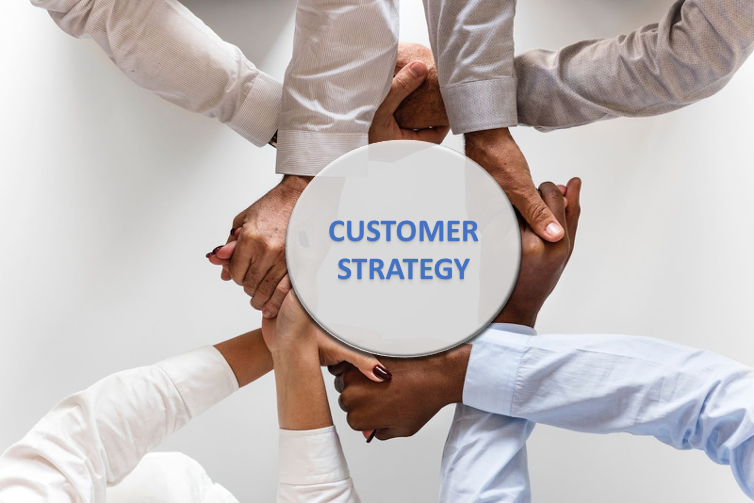Starting a clothing business can be daunting with all the dynamism, competition and complexities involved in the fashion industry. However, unlike professions like doctors, nurses, lawyers who need special training and a degree, the same is not mandatory for starting a clothing business.
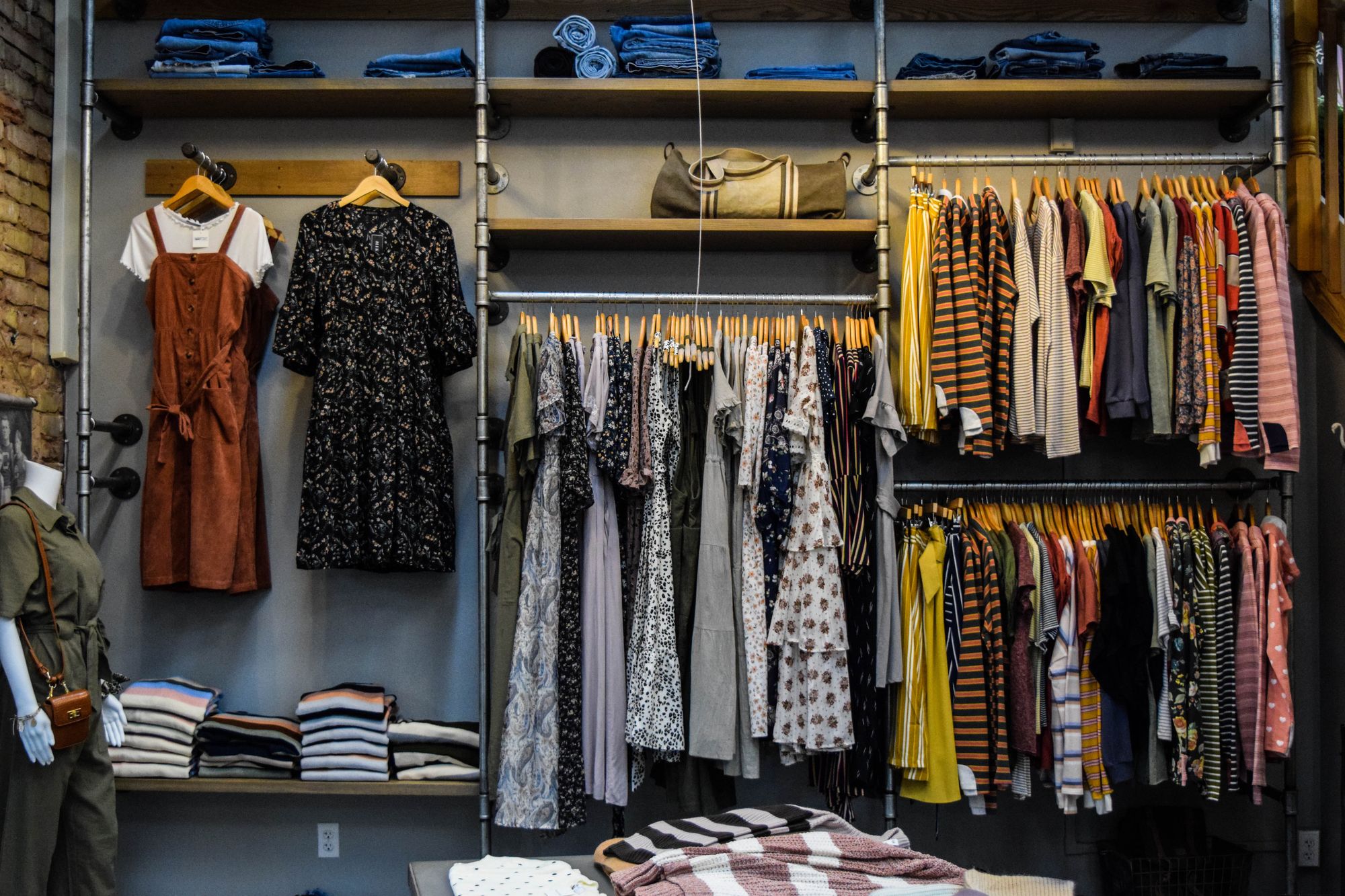
To start a clothing business, the prime requisites are passion and an eye for clothes, fashion, design and the knack of picking up trends and even foreseeing them. The 2nd requisite is to understand what your target market is looking for and give them that in the best possible manner.
It is only after these requisites are fulfilled that you will be moving on to the next step of setting up your clothing business. To start your clothing business, you need to dedicate all your time and energy to it.
The first step to start your clothing business is to gain the confidence as well as the assurance to do so. This should be followed by self-motivation, determination and passion to become an expert in your field.
Once you have these and the understanding that your clothing business will start and survive only with long hours of work, strong organizational skills and a steep learning curve, you will be prepared to go to the next steps. This article will take you through the most important steps for starting a clothing business.
13 Steps to Start a Clothing Business
Starting a clothing business can be a very rewarding experience for an entrepreneur who is creative and with a vision.
Irrespective of whether you want to start a line of printed cloth editions, or a clothing business that has cutting and sewing services with seasonal variations, the basics to start a clothing business remains the same.
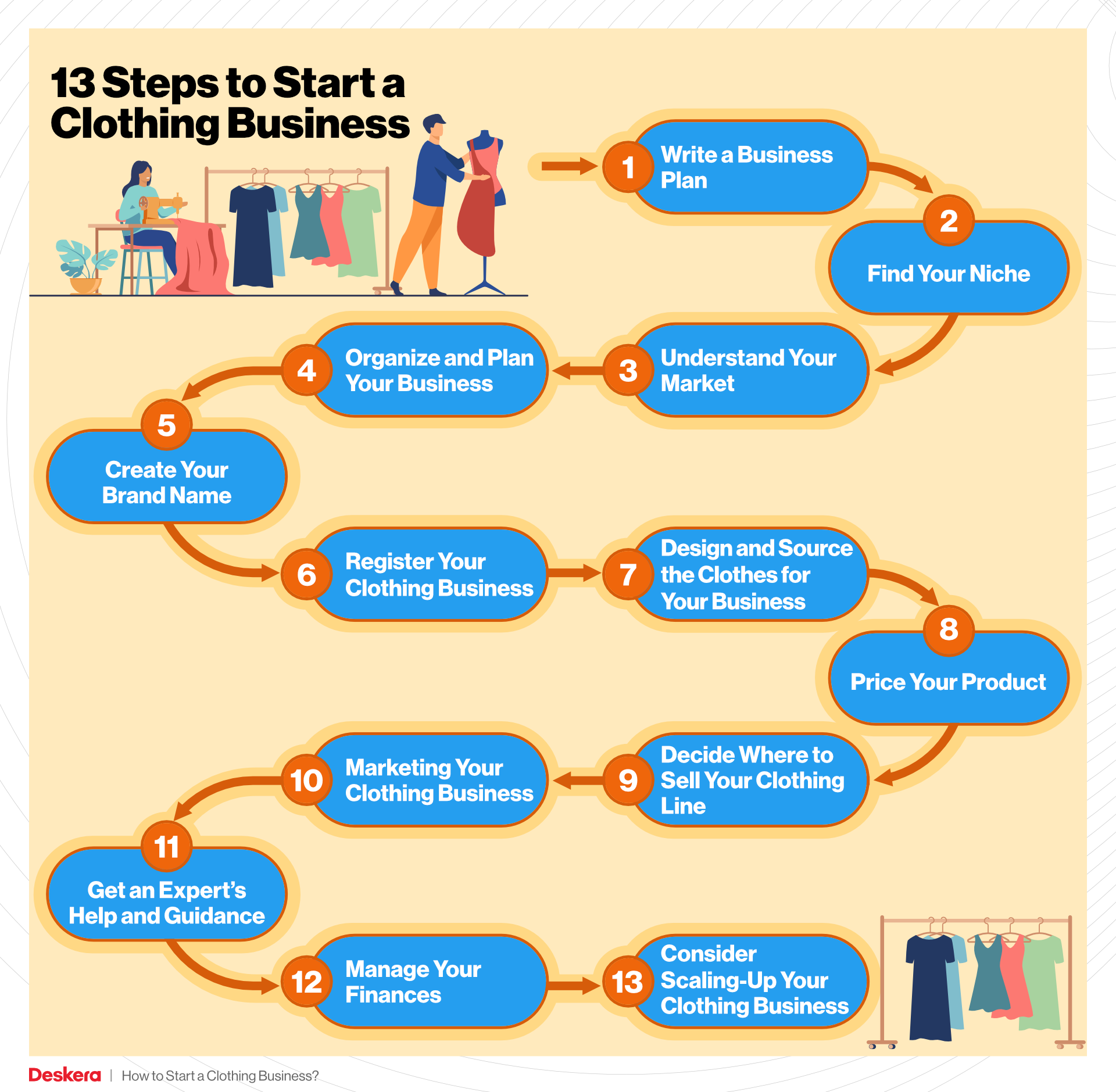
Therefore, the 13 steps to start a clothing business are:
Write a Business Plan
Writing a business plan before starting your clothing business will act as the roadmap of how your business is going to reach its goals over the next couple of years.
A business plan is not to be written in rock and can be updated with changing trends, goals and needs.

However, having one is as important as having a business plan that is flexible and adaptable to the customers and the environment.
Another benefit of having a business plan is that at times of navigating through the changing waters of the fashion industry, you will feel a lot less overwhelmed.
Your clothing line business plan should also have details on funding and how you are planning to use it and to achieve which of the goals. Your budget would also be dependent on whether you want to design your own clothes or get them from a wholesaler.
Either way, starting small with designs/clothes on which you have already received positive feedback and with basic equipment is the way to go about it. Later, with increasing business, you can expand your budget as well.
If your business will need funding or support of other kinds, your business plan will also have to include details like an executive summary and how your business is going to grow and expand and expected return on investment.
After your business plan, you should also write your clothing business proposal as this would help you convert your potential customers into sales.
Find Your Niche
Starting a clothing business is as personal a journey as it can get. If you want to start your clothing business, it is quite likely that you want to offer something different in the fast-moving fashion industry or that you have found a gap in the market or you have something different to offer to a specific customer group. Based on what this is, you decide your niche right from the start.
Even if over time you add lots of branches and sub-branches in designing and the products you offer, your original idea- which was your niche gives you the heritage, a guiding principle and a reason to be remembered by others. It is like developing a strong distinct brand image for your clothing business right from the start.
Understand Your Market
Your business idea should be followed by the backing of market research. Market research will give insights like fabric choices, designs, sourcing and production budget and retail outlets.
These insights would be based on the target market’s spending behavior, lifestyle, aesthetic preferences and shopping location preferences like eCommerce platforms or brick and mortar stores.

Market research should also include competitor research and their products, marketing, branding strategies and the value they are providing to their customers. Understanding competitors would be an important part of forming a market penetration strategy.
Understand your market entirely to start your clothing business like this too will serve as the guiding principle for your decisions.
Organize and Plan Your Business
Organizing and planning your business based on your long term goals is important.
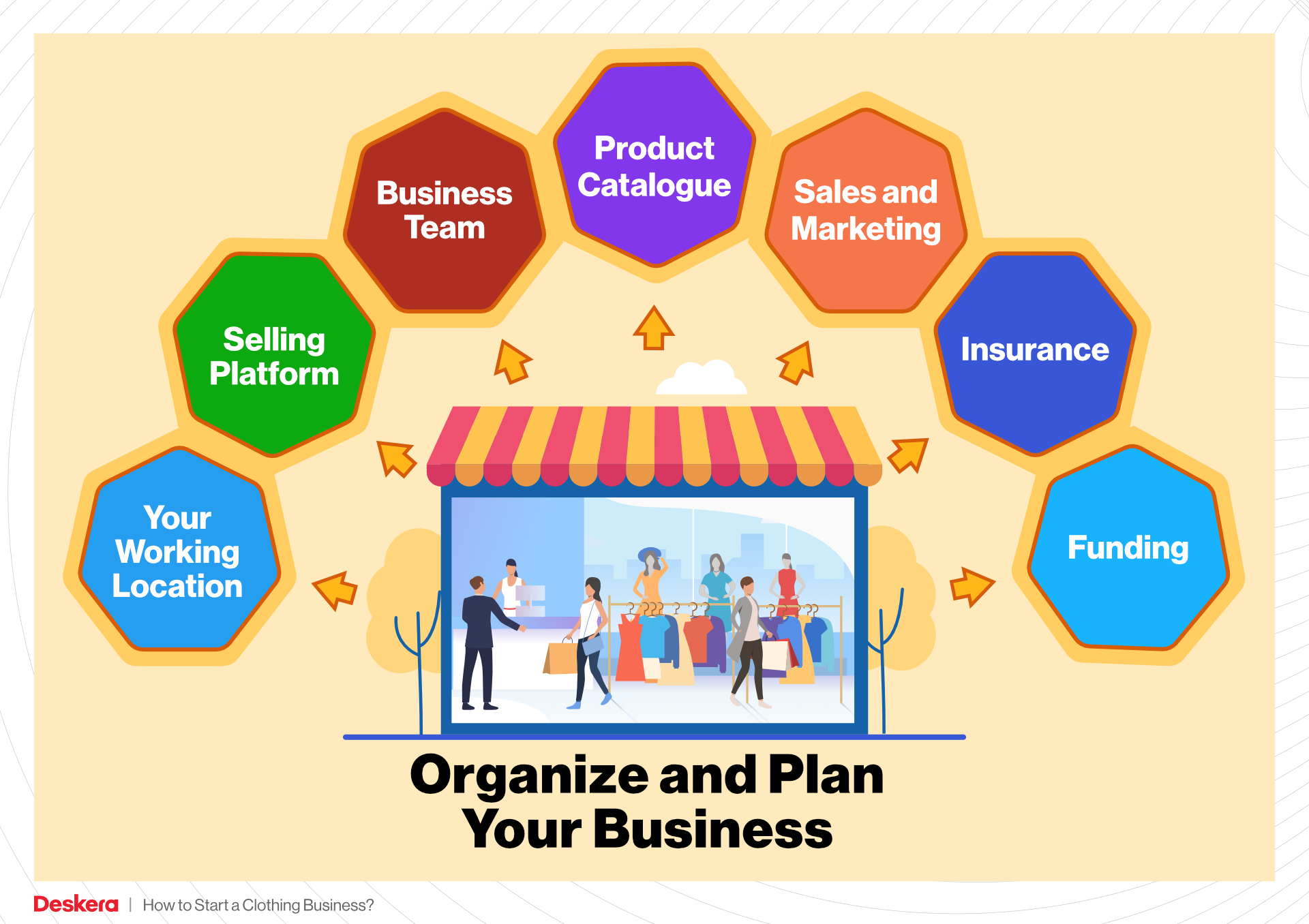
This includes the following details:
- Your Working Location- for example, you might start your clothing business from your bedroom and would want to take it to a studio.
- Selling Platform- are you going to sell on stalls, or Instagram shopping or are you going to be a retailer or are you going to have your own brick and mortar shop? Based on where you plan to sell from, your strategies will have to change.
- Business Team- are you going to be the sole manager of your clothing business? Or are you going to have a designer, an accountant, a salesperson and so on?

- Product Catalogue- what will be your product list and how are you going to manufacture, store and sell those products? This will especially include inventory management.
- Sales and Marketing- this will include marketing plans for creating a buzz around your products, increase sales, improve customer retention and increase returning customers. How you will be using social media, websites, blogs and other such platforms for your clothing business will be determined here. This will also include deciding on a system to track and integrate your cash flow statements, balance sheet, profit and loss statement and gross profit and gross revenue.
- Insurance- depending on the type of your clothing business, you will have to decide on the type of insurance you will be taking to safeguard your business against unforeseen circumstances and risks. This can be stock cover insurance, online retailer insurance, and product liability insurance to mention a few.
- Funding- you will have to have an idea of the funds you already have and the funds that you need. Looking for sources like start-up funds to fulfil your funding needs is a must before starting your clothing business. You will also have to decide on accounting software like Deskera for your business to handle all your finances including taxations, invoices, reminders and even email marketing campaigns.
Create Your Brand Name
Based on your niche as well as the target audience, create your brand name to represent your business goals and appeal to the audience. Having your brand positioning statement will become your guiding factor for all your future business functions.
If your designs are something that represents you and your creativity, your name can also become your brand name, like Tommy Hilfiger. If your designs are for kids, your brand name could be something like, “sunflowers and kids.” If your clothes are for explorers and travelling, your brand name could be “Wanderleen.”
Deciding your brand name is a big deal as it is the first impression that your business is going to leave on its potential customers. Having it represent you and your clothing business is therefore very important. Taking this under consideration, building the brand awareness for your clothing business is thus equally important.
Register Your Clothing Business
Once you have decided on all the nitty-gritty details mentioned above, it is time to register your clothing business and make it a legal entity. To do so, you will have to decide on your business entity types like sole proprietorship or partnership.
You will also need to get the necessary business licenses and permits like sales tax licenses, home occupation permits, etc. Lastly, you will need to get an employer identification number through which you will be able to pay your business taxes. This will also help you to open your business bank account and access business financing.
Design and Source the Clothes for Your Business
After all, the legal requirements are fulfilled and your business is official, it is time to get your hands on the central part of your clothing business. If you have not worked in the fashion industry before, this part could be more challenging for you, but not impossible.
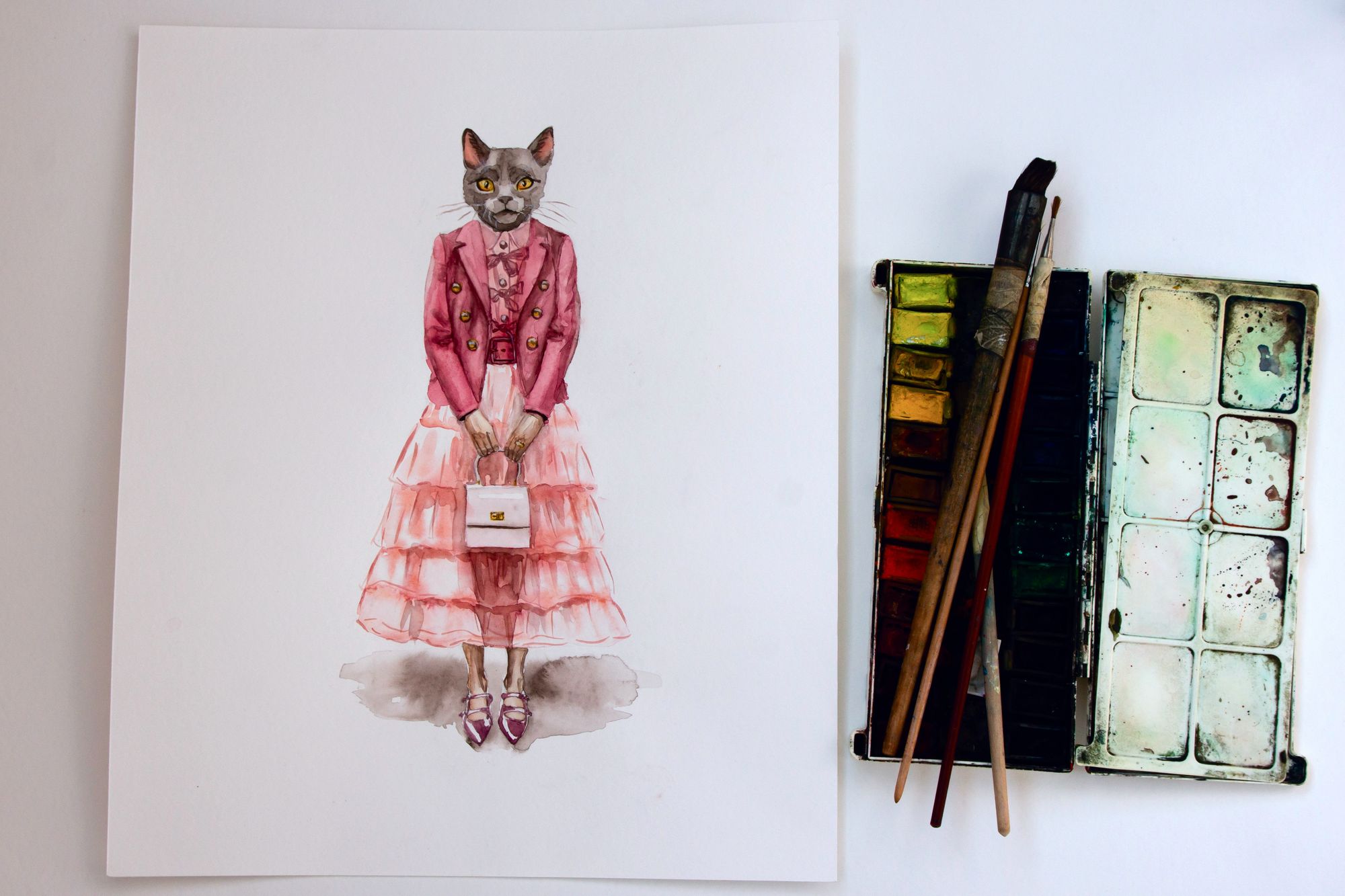
Here are the steps to do this right:
- Finding the Right Materials- You might be clear on the types of materials you want to work with, or you might need to do some exploring first. Either way, your materials are decided based on your product list and your niche. For instance, if you are designing wedding gowns, white materials of silk, satin and lace would be your choice. Once you have decided on your material, the next step is to reconcile your costs with the quality of the material. While cost-cutting is important, so is long-lasting quality material. Therefore if it means keeping the prices higher than your target point, do it.
- Partner with a Manufacturer- Partnering with the right manufacturer is important to start your clothing business as they would be responsible for bringing your vision and goal for your brand to life. Your manufacturer will have to produce according to your specifications and quality while staying true to your concept. Choosing your manufacturer would also be based on their minimum order quantity, cost, quality and trustworthiness. You can also consider manufacturing overseas to cut down on costs and increase affordability. The key to maintaining your integrity through your manufacturers is by starting with the perfection of a few items, see how the market reacts and build up your brand from there.
- Decide Your Packaging- Along with the manufacturing of your clothes, deciding on your packaging which represents your brand is also important. Your packaging should have a long term value and life. It should have a way for potential customers to be able to contact you. One of the best ways to use your packaging as your marketing tool is by making it an aesthetic multi-utility bag with your branding and contact details right on it.
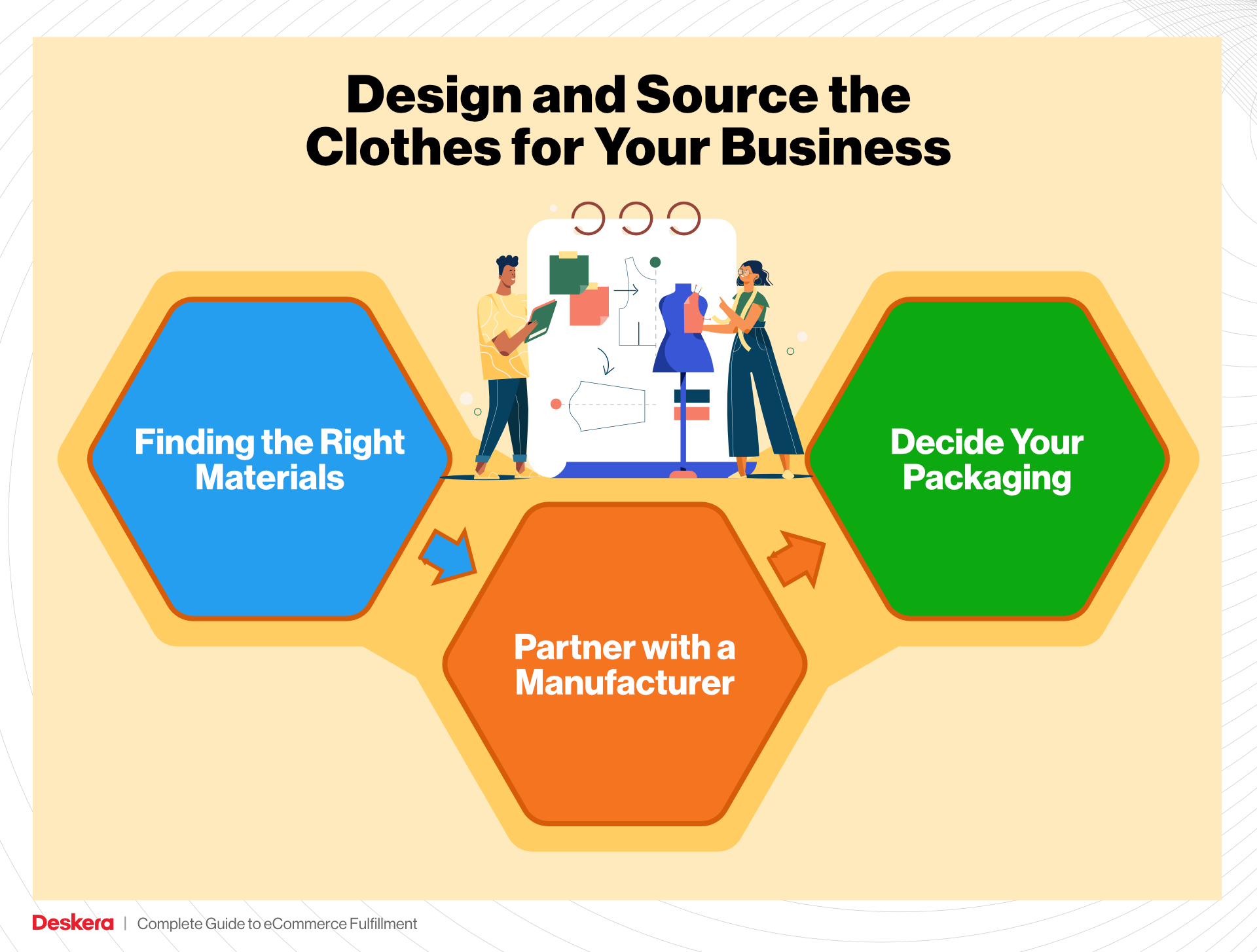
Price Your Product
Once you have found your materials, manufactured your clothing line for your clothing business and decided on its packaging, you will have to decide the price for your products. Your products’ prices should be balanced between earning a profit and keeping a price that the customers would be willing to pay.
The market research undertaken before will be useful here to understand the demographic trends of your target market. With time, you can change your initially decided price in line with your customers and the environment around you.
For instance, if your target is to provide budget-friendly gym clothes for all, your prices should be decided accordingly. If in addition to this, you add super durable, waterproof and sweatproof clothes for fitness competitions, these would be priced higher than your gym clothes. This is based on the understanding that one would be likely to spend more on competitions, than for everyday short-time wear.
Decide Where to Sell Your Clothing Line
The decision on where you would be selling your clothing line would be made during making a business plan. What needs to be done now is to undertake the process for selling your clothing line on the decided platform.
According to the current trends, your selling platforms would be Instagram shopping, Facebook marketplace, eCommerce platforms like Amazon, eBay, Etsy and your website. To assist your selling place, have a social media page on Instagram, Facebook and Pinterest that features your work.
These pages would be especially useful if you plan to start your clothing business online, which would be more affordable and manageable. Choosing a platform with creative templates is a must as they would represent your brand to your potential customers.
Also, having a platform that supports product variations like size, colours and materials is a must for your clothing business. Some of the platforms that support these are Shopify, BigCommerce and WooCommerce. Deskera offers to manage your product variations through its platform. Here's how:
In case your demographic trends are such that you want to set up a brick and mortar shop and you are also able to arrange the funds for the same, these social media pages will bring more engagement and exposure for your clothing business.
If your online business succeeds, you can always open up a brick and mortar store at that point in your clothing business journey. You can also find resellers for your clothing line.
Marketing Your Clothing Business
To keep the doors to your clothing business- digitally or physically open, marketing is even more important than your sales. Without a proper marketing plan, all your efforts would be for naught.
Some of the most successful fashion businesses use their free social media platforms like Instagram and Facebook to market their products, connect with their potential customers, increase engagement and exposure with their business and thereby increase sales.
In the current scenario, these platforms are found to be more transparent and allow a better current connection with your customers which helps in winning their trust and belief in you.
Customer feedback gained through these media helps in improving customer experience and ensures the voice of the customer. It improves customer retention, increases social selling and the net profit of your clothing business.

One of the other ways of reaching your customers is through email marketing. Understanding and incorporating email marketing funnels will convert prospective sales into confirmed sales.
Within this funnel, use email marketing strategies, email marketing templates and email marketing automation tools like Deskera. When used collectively, all of this will not only digitize customer service but also bring more customer satisfaction and hence an increasing trajectory for gross profit.
Irrespective of the platform and the manner, the key to successfully marketing your clothing business lies in consistency and cohesion. Every marketing piece and campaign should align with your brand’s voice, goals and aesthetic. The type of marketing should create a brand awareness that is aligned with your vision for your clothing business.
Your marketing should be adapted to your customer’s buying behaviour and preferences. It should continuously be in touch with your customers by sharing with them updates about your clothing business, new launches, offers and asking for reviews for sales already delivered. Taking special care here will help you to win your customer’s loyalty and over the long run, turn leads into sales. It will also ensure returning customers to your clothing business.
You should also make sure that as a small business marketing, your marketing campaigns should be more innovative, personal, in-line with the trends, it can even have an opinion on social and political issues and overall be more active in marketing.
Get an Expert’s Help and Guidance
The idea behind your clothing business might entirely be yours, but hiring an expert in the industry would give you the help and guidance that you need. This can make the difference between the success and failure of your clothing business.
An expert would help you with competitor’s positions, what your brand positioning can be and how to go about your clothing business. They will also be able to help you connect with the necessary vendors and support staff.
However, while choosing an expert to guide and help you, always follow your gut. Your gut feeling knows what is right and wrong and they know you the best. To find a reliable and trustworthy expert, word-of-mouth and profile pages like LinkedIn are the most reliable sources.
Manage Your Finances
To start your clothing business, and then to make sure that it continues successfully, it is very important to manage your finances. The key way of managing your finances is by keeping regular track of your financial statements like profit and loss statements, cash flow statements and balance sheets. The financial reporting practices that your clothing business follows has as huge an impact as bringing success or failure to your business.
It is also important to keep a real-time track of your operating expenses, operating income, account payable, account receivables and therefore revenue and profit. This should be followed by having a system in place for your invoices and sending out invoice reminders.
In fact, you should have an invoice management system in place for your clothing business. Lastly, your clothing business should also have an accurate calculation of your tax payables.

Business decisions and activities should be based on real-time insights along with all these factors and one way of doing that is by integrating these data on a platform like Deskera.
Platforms like Deskera Books, Deskera CRM, Deskera Sales pipeline help you to analyse your finances in real-time and make informed decisions. These records are accessible anywhere and are therefore a boon for your clothing business.
To better manage your clothing business finances, you should be well versed with bookkeeping basics, accounting for small businesses, income statement for small businesses and accounting tips to save you money.
Consider Scaling-Up Your Clothing Business
After the first couple of seasons during which you observe your clothing business trends- financially, progress, client’s reaction and future prospects, you can consider scaling up your business.
Scaling up your business is not going to be an easy task, especially with the additional costs, responsibilities and most probably more employees helping you out, but it may well be worth it if your trends suggest so. So go by your business insights, discuss it with your expert guide and go by your gut feeling before making any decisions.
How can Deskera Help You in Starting Your Clothing Business?
Deskera is an all-in-one small business software that handles your accounting, financial reports, payables and receivables, taxations, invoices, invoice reminders and many such business activities all at one place and at the same time.
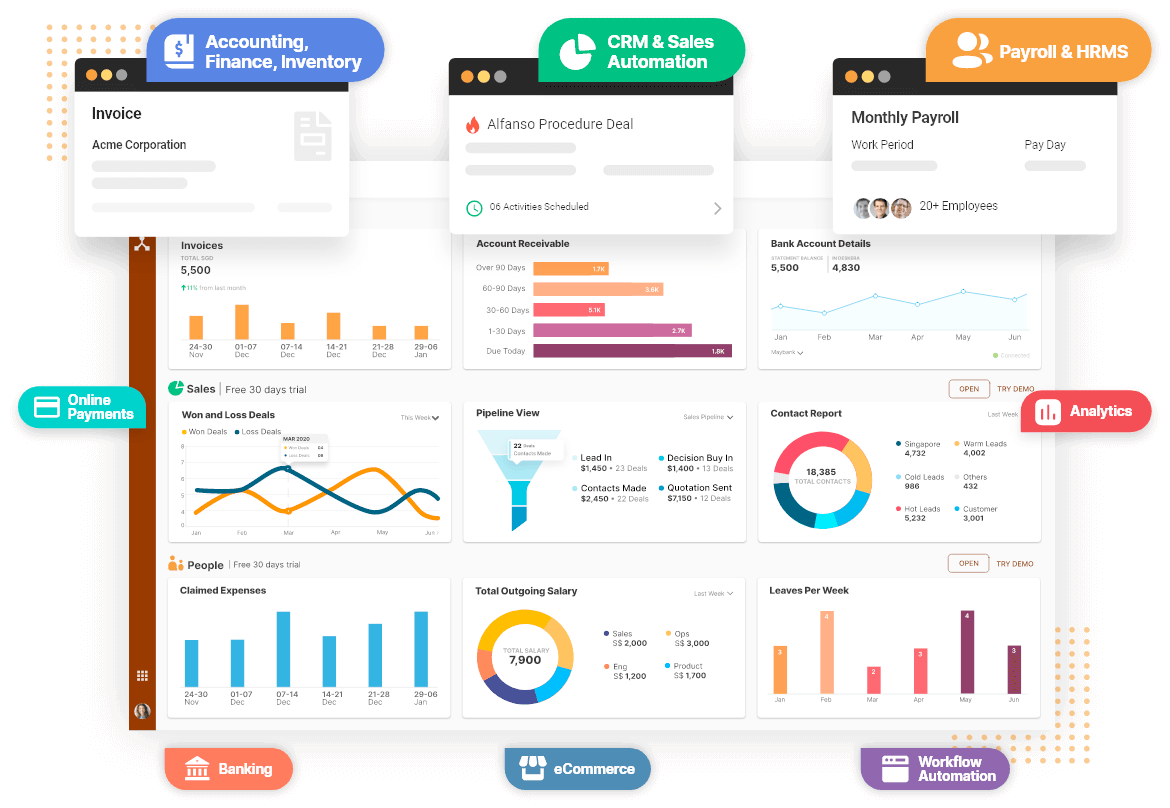
It also has an advanced inventory management system that can keep a track of the multiple warehouses, stock transfers and adjustments and bills of materials to mention a few functions.
The analysis undertaken by it is very useful in predicting the future of your clothing business and be better prepared for upcoming threats as well as opportunities.
Through its automated system, Deskera books also make it possible for your clothing business to always give timely deliveries to your customers. This will increase their satisfaction with your business and ensure their return to you.
By being affiliated with various banks and payment options, Deskera books will also make it easier for your customers to make your payment which will hence improve your cash flow balance. A positive cash flow will facilitate the growth and development of your business which in turn will earn you more revenue.
Deskera books will manage your sales and orders from their start till the finish, and will also make the invoices on your behalf and send them to your customers. If the invoice payment is delayed, it will also take follow-ups with your customers- or at least remind you to do so.
Deskera books will also assist you to pick pack ship your orders as well as track your drop shipped orders.
Further on, Deskera CRM will help in contact and deal management, sales pipeline, email marketing campaigns as well as customer support to mention a few important functions.
All in all, Deskera will enable you to track your business’s key performance indicators in real-time, facilitate faster and well-informed decisions and improve cash flow for your clothing business.
Key Takeaways
The key to start and own your clothing business is patience, adaptability and dedication. These will help you to maneuver through the fast-changing trends and fulfil your customer’s needs and wants. It will also ensure that you always keep learning which will further be beneficial for your clothing business.
Many small businesses are slightly easier to start than starting a clothing business and there would be lots of challenges along your way, but if that is your passion and love, it would be very rewarding for you. Seeing your customers in your own designs- nothing could be more satisfying than that.
The 13 steps to start your clothing business are:
- Write a Business Plan
- Find Your Niche
- Understand Your Market
- Organize and Plan Your Business
- Create Your Brand Name
- Register Your Clothing Business
- Design and Source the Clothes for Your Business
- Price Your Product
- Decide Where to Sell Your Clothing Line
- Marketing Your Clothing Business
- Get an Expert’s Help and Guidance
- Manage Your Finances
- Consider Scaling-up Your Clothing Business
With this guide to start your clothing business, all that is now left is for your dream to become a reality. We, the team of Deskera, are here to assist you in all the manners possible.
Some More Related Articles



